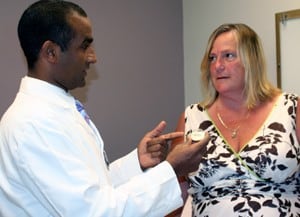UAMS Cures Patient’s Incontinence, Prevents Need for Dialysis
| Incontinence turned Laurene Payton’s life upside down for more than a year.
“I couldn’t cough, sneeze, run, jump,” said Payton, 45, whose problem developed after back surgery. “It’s kind of embarrassing to go anywhere when you have that condition, so I didn’t get out much.”
Then her prognosis became even more dire.
Payton, of Hot Springs, learned that her improperly functioning bladder was causing urine to back into her kidneys, and without a solution she was facing kidney dialysis.

UAMS’ Ayman Mahdy, M.D., and Laurene Payton discuss the implant that was used to successfully treat Payton’s incontinence.
Her nephrologist referred her to Ayman Mahdy, M.D., a urology specialist at the University of Arkansas for Medical Sciences (UAMS). Mahdy, who has expertise in voiding dysfunction, female urology,urodynamics and urologic reconstruction, performed a comprehensive evaluation.
The evaluation, used to rule out bladder infection and other problems, includes a urodynamic study – a performance assessment of the bladder and urethra. The test revealed overactivity of the muscle that controls the bladder, which was causing Payton to urinate involuntarily. She also was retaining excess urine.
Mahdy determined that the nerve controlling her bladder muscle – the sacral nerve – was the problem. He recommended that Payton try an implant that uses electrical impulses to calm the nerve.
Before implanting the InterStim® device under Paytons’ skin at her lower back, Mahdy first tested its effectiveness using a device that she wore externally.
Mahdy and Payton were pleased with the results, so Payton chose to have the implant procedure. She was under conscious sedation for the one-hour minimally invasive surgery, and she went home the same day.
Made by Medtronic, the InterStim® Therapy implant is the only FDA-approved device of its kind. The implant allows patients to resume daily activities without having to carry or see the device. A remote control allows Payton to turn it on and off and to change the stimulation amplitude up and down. Otherwise the device works on/off automatically.
Three months after the implant, Payton said she is essentially cured, thanks to the device.
“I’ve had great success,” she said. “Dr. Mahdy did a wonderful job. This is a procedure that’s simple and it works.”